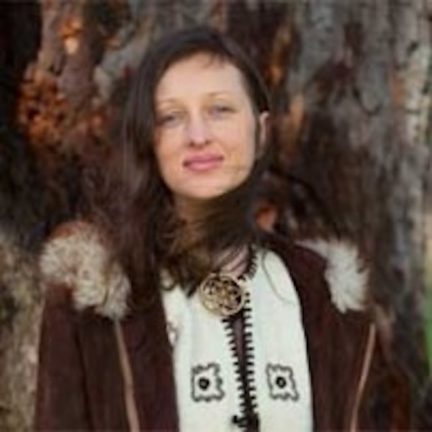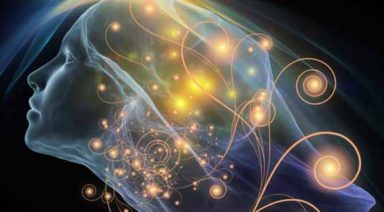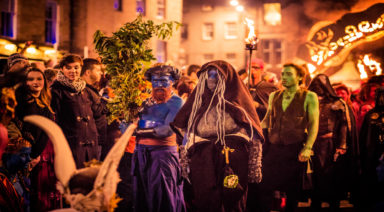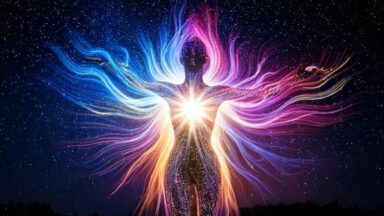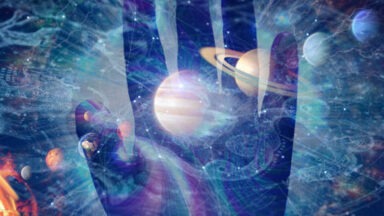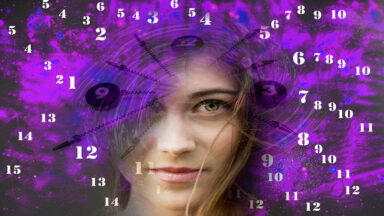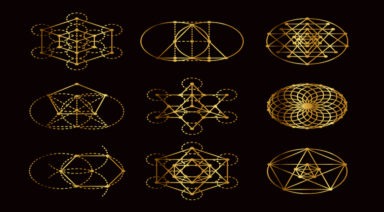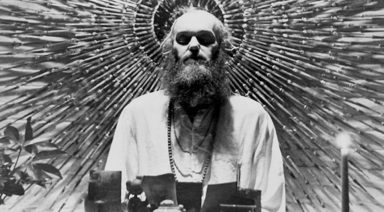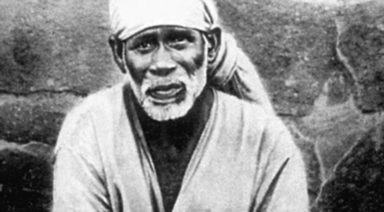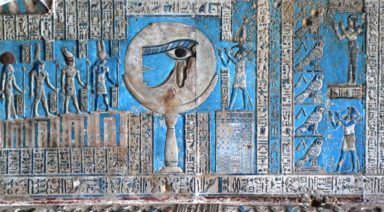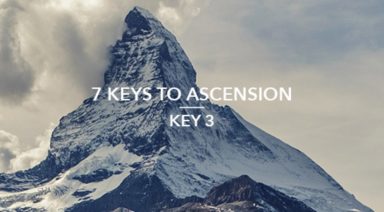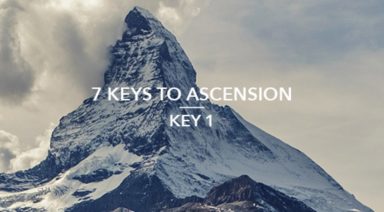Ascension and Raising Our Energetic Frequency

Energetically we are vibrating at a certain frequency right now. We might be feeling anxious, lethargic, excited, upbeat, moody, or just a bit ho-hum. Each of these feelings has a frequency that creates sensations in our bodies and emits energetic vibrations to everything around us. These are the energetic atmospheres in which we live and experience life through, whatever our circumstances may be.
Our Energetic Frequency – Our Home and Destiny
While we usually identify ourselves with our bodies, what we are inside continues in our existence beyond the body as those who’ve had near-death experiences testify. Our energetic state is really important then, as it’s not only the environment in which we live, but it determines where we manifest now and in the future in this vast multi-dimensional creation.
Near-death experiencer Arthur Yensen stated that a spiritual being explained it to him like this in his near-death experience:
If you threw a small pebble into a threshing machine, it would go into the box – not because it is good or bad, but because of its proper size and weight. It’s the same way here. No one sends you anywhere. You are sorted by the high or low vibrations of your soul. Everyone goes where he fits in! High vibrations indicate love and spiritual development, while low vibrations indicate debasement and evil.
Each of our thoughts and emotions causes our energy to vibrate at a particular frequency; the higher the frequency, the more spiritual we feel. The experiments of Dr. Emoto, in which water was subjected to different emotional vibrations — where feelings like gratitude produced exquisite water crystals whilst derogatory insults produced an ugly mess—have perhaps come the closest to proving this physically.
That’s why when we feel lighter, we tend to be more spiritually perceptive and able to have mystical experiences. Whilst we associate heavy and low-frequency states like hatred, anger, depression, and fear, with being blinded and dragged down.
The Vibratory Scale of Our Own Feelings
We don’t have to look far to see these principles in action, as in this fractal holographic universe, the same fundamental principles appear at all scales and in all dimensions. Colors, musical tones, light, focused life force energy and chemical elements, all vary in their vibrational frequency, and thus in their ranges of density and “heaviness.” The lower the frequency of a musical note, for example, the more “disturbing” it sounds, whilst higher notes we tend to find uplifting and more “spiritual” sounding.
The principles of harmony and discordance also apply, which is why when someone is out of accord in a group setting we can describe them as being “out of tune”. Discordance at all frequencies is associated with ugliness and chaos, giving us that jarring feeling like when someone plays a song out of tune; whilst harmony is associated with beauty and order, giving us that sublime sense of tranquillity as things come into resonance with the underlying spiritual principles of creation, like the voices of a choir singing in unison.
The Evidence for Ascension in Sacred Texts and Sites Around the World
Whatever our current energetic vibration, it is possible to raise it up and ascend the scale. This understanding is key to unlocking many of the mysteries that have been encoded in sacred teachings throughout time.
From the beginning of history we find spiritual figures, such as Krishna, Jesus, Osiris, Mithras, and Quetzalcoatl, who left behind clues to a process of inner change that ultimately leads to ascension.
The Medieval alchemists purified heavy metals into gold. Some of the most enigmatic and powerful sacred sites, like Stonehenge, the Sphinx of Egypt, the Moai of Easter Island, Serpent Mound of North America, and Essene Monastery at Qumran, all align to the summer solstice, a time associated with the ascension to source as the time of greatest light in the year.
Although seemingly disparate, they all essentially describe the same kind of fundamental process of spiritual ascension, in which what is base and lower is transformed into something higher and more spiritual.
The Principles of Ascension Found in the Design of the Universe
Additionally, as the source of the universe is spiritual, everything created is imbued with these spiritual principles, and so they can literally be found everywhere we look—even in the microscopic fabric of the universe. For example, creation begins from the lightest particles emitted from an unmanifest source, which eventually creates stars that rearrange atoms to form and condense into increasingly heavy elements. One day, all that is created will be absorbed back into the stars where it will be broken down and stripped back to its original light state.
At its most basic level, the journey of our consciousness follows this same process. We came from a spiritual source and descended through the higher dimensions until coming into matter and dense form both physically and psychologically.
Ascension is to free oneself from the dense and heavy states that imprison us—and retrace our steps back through the higher frequency and more spiritual dimensions to return to our spiritual home having gained self-consciousness in this plane of learning.
By becoming aware of our inner moods, emotions, thoughts, and feelings, and choosing to vibrate at a higher level instead, we’re putting this universal process of ascension into practice.
Going further, there are principles of chemistry and creation, which if applied inwardly, can be used to transform our energetic make-up and raise our frequency permanently. But even just living each moment differently helps toward ascension.
Getting Started With Ascension Today
We can try it at any time—become aware of the sensations you feel in the area particularly around your solar plexus, the center of emotion. Also try becoming aware of your underlying thought patterns, which often trigger feelings like heaviness in the region of the abdomen. See if you can shift any heavy feelings along with any thoughts that may be triggering them—take a walk and just perceive the elements of nature in order to shake them off if you need to—and then come back and try to maintain a sense of lightness and clarity.
Even by doing this simple exercise, we can ascend further than we were before, and the sum of ascending each day can raise our overall vibrational frequency.
Who is Sophia in Gnosticism? Goddess of the Divine Feminine
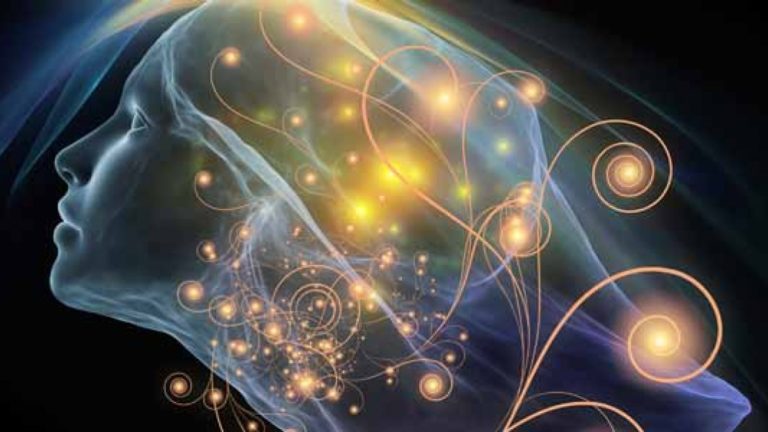
Sophia, the embodiment of divine wisdom in Gnostic tradition, graces us with a profound understanding of the feminine aspect of the cosmos. Gnosticism—interwoven with early Christianity and enriched by Hellenistic philosophy—is more than a religion; it is a journey toward self-realization and communion with a deeper reality. This sacred knowledge, known as Gnosis (from the Greek “to know”), was lovingly passed down through myths found in Gnostic texts such as those discovered in the Nag Hammadi library.
The Myth of Sophia: The Divine Feminine
Let us immerse ourselves in the enchanting myth of Sophia, whose story illuminates the depths of divine wisdom and the sacred feminine.
Sophia’s Origin in the Pleroma
In Gnostic cosmology, Sophia is the radiant feminine personification of divine wisdom and the youngest of the Aeons—emanations of the ultimate reality known as the Monad or Pleroma. Dwelling in the spiritual fullness of the Pleroma, Sophia is intimately connected with the unknowable Father’s brilliance, born of the twin powers of Depth and Silence.
The Descent and Creation of the Material World
Compelled by an intense yearning to know the Father’s essence, Sophia emanates without her consort, creating a disturbance that leads to her descent from the Pleroma. In her fall, she becomes entwined in the material world, inadvertently giving birth to the Demiurge, often called Yaldabaoth. This ignorant and arrogant entity fashions the material universe, unaware of the spiritual realms above. In certain Gnostic scriptures like the Apocryphon of John, the Demiurge is equated with the God of the Old Testament.
Sophia’s descent introduces imperfection, suffering, and ignorance into existence, as the material world is shaped through her unintended actions.

